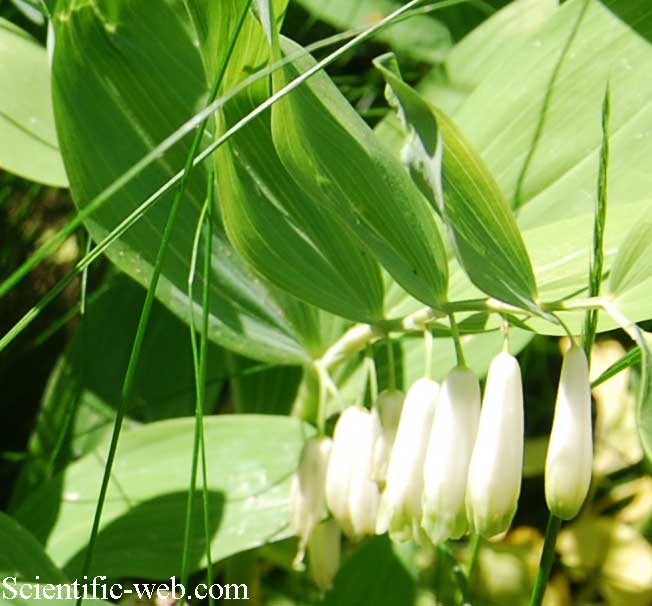
Polygonatum odoratum, Photo: Michael Lahanas
Classification System: APG IV
Superregnum: Eukaryota
Regnum: Plantae
Cladus: Angiosperms
Cladus: Monocots
Ordo: Asparagales
Familia: Asparagaceae
Subfamilia: Nolinoideae
Tribus: Polygonateae
Genus: Polygonatum
Species: Polygonatum odoratum
Varietates: P. o. var. maximowiczii – P. o. var. odoratum – P. o. var. pluriflorum – P. o. var. thunbergii
Name
Polygonatum odoratum (Mill.) Druce, (1906).
Synonyms
Homotypic
Convallaria odorata Mill., Gard. Dict. ed. 8: 4 (1768).
Polygonatum sigillum Druce, List Brit. Pl.: 69 (1908), nom. superfl.
Hybrids
Polygonatum × hybridum Brügger
References
Druce, G.C. 1906. Ann. Scott. Nat. Hist. 1906: 226.
Govaerts, R. et al. 2011. Polygonatum odoratum in World Checklist of Selected Plant Families. The Board of Trustees of the Royal Botanic Gardens, Kew. Published online. Accessed: 2011 Sept 05. Reference page.
USDA, ARS, Germplasm Resources Information Network. Polygonatum odoratum in the Germplasm Resources Information Network (GRIN), U.S. Department of Agriculture Agricultural Research Service. Accessed: 07-Oct-06.
Vernacular names
العربية: عقداء عطرية
azərbaycanca: Ətirli toyçiçəyi
čeština: kokořík vonný
Cymraeg: Llysiau-Solomon persawrus
dansk: Kantet Konval
Deutsch: Echtes Salomonssiegel, Duft-Weißwurz, Wohlriechende Weißwurz
English: Angular Solomon's Seal, Scented Solomon’s-seal
español: beatamaría, lágrimas de David, poligonato, sello de Nuestra Señora, sello de Salomón, sello de Santa María, suelda blanca
eesti: Harilik kuutõverohi
فارسی: پلیگناتوم ادراتوم
suomi: Kalliokielo
français: Sceau de Salomon odorant
hornjoserbsce: Jednokwětna kokorička, Běły korjeń
magyar: Soktérdű salamonpecsét, orvosi salamonpecsét, szagos salamonpecsét
日本語: アマドコロ(甘野老), アマドコロ, 玉竹, ギョクチク, 萎蕤, 甘野老, イズイ
қазақша: Дәрілік қырлышөп
한국어: 둥굴레, 둥글레
lietuvių: Vaistinė baltašaknė
norsk bokmål: Kantkonvall
Nederlands: welriekende salomonszegel
polski: Kokoryczka wonna, Polygonatum officinale
русский: Купена аптечная, Купена душистая, Купена лекарственная
slovenčina: kokorík voňavý
svenska: Getrams
Türkçe: Kokulu mührüsüleyman
українська: Купина лікарська
Tiếng Việt: Ngọc trúc
中文(简体): 玉竹
中文(繁體): 玉竹
中文(臺灣): 玉竹
中文: 玉竹
Polygonatum odoratum (syn. P. officinale), the angular Solomon's seal or scented Solomon's seal, is a species of flowering plant in the family Asparagaceae, native to Europe, the Caucasus, Siberia, the Russian Far East, China, Mongolia, Korea and Japan.[1][2][3][4] In the United Kingdom it is one of three native species of the genus, the others being P. multiflorum and P. verticillatum.
The genus name Polygonatum comes from the Greek words "poly", meaning "many", and "gonu", meaning "knee joint". This is in reference to the plant's jointed rhizomes. The Latin specific epithet odoratum means "scented".[5]
Description
Polygonatum odoratum is a colonizing herbaceous perennial growing to 85 cm (33 in) tall by 30 cm (12 in) wide, with alternate, simple leaves on arching stems. The scented tubular flowers are white with green tips, borne in spring and hanging from the underside of the stems.[2]
Cultivation
Polygonatum odoratum, like its relative lily of the valley, is cultivated in moist, shaded situations, where it will spread by underground stolons.[6] Cultivars include 'Flore pleno'[7] and 'Variegatum'.[8]
Use
Dunggulle (lesser Solomon's seal roots
Polygonatum odoratum is used in traditional Chinese medicine and Traditional Korean medicine, where it is called yùzhú (玉竹) and dunggulle (둥굴레) respectively. In Korea, the root of the plant is used to make tea.
This plant species is described in the work Plantas Medicinales (medicinal plants) of Pius Font i Quer.[9] According to it, its rhizome contains asparagine, mucilage, a cardio-tonic glycoside, saponin, and quinine gluconate. It has been used for intestinal problems and pain, for rheumatism, gout, water retention, and as a diuretic. He says that the scientific medicine has used it to treat diabetes. He also describes a digestive liquor that uses the rhizome of this plant.
The young shoots of the plants may be boiled and served like asparagus. The stems, leaves, and berries, however, must be treated with caution, as they are thought to be toxic if consumed in large quantities.[10]
Varieties
Four varieties are recognized:[1]
Polygonatum odoratum var. maximowiczii (F.Schmidt) Koidz. – Japan, Russian Far East
Polygonatum odoratum var. odoratum – widespread from Portugal and Great Britain to Japan and Kamchatka
Polygonatum odoratum var. pluriflorum (Miq.) Ohwi – Japan, Korea
Polygonatum odoratum var. thunbergii (C.Morren & Decne.) H.Hara – Japan, Korea
References
Kew World Checklist of Selected Plant Families
RHS A-Z encyclopedia of garden plants. United Kingdom: Dorling Kindersley. 2008. p. 1136. ISBN 978-1405332965.
Flora of China, Vol. 24 Page 226, 玉竹 yu zhu, Polygonatum odoratum (Miller) Druce, Ann. Scott. Nat. Hist. 60: 226. 1906.
Altervista Flora Italiana, Sigillo di Salomone comune, Angular Solomon's Seal, Polygonatum odoratum (Miller) Druce includes map of distribution in Europe
"Polygonatum odoratum var. pluriflorum 'Variegatum' - Plant Finder". www.missouribotanicalgarden.org. Retrieved 2021-03-12.
"RHS Plant Selector – Polygonatum odoratum". Retrieved 28 May 2013.
"RHS Plant Selector – Polygonatum odoratum 'Flore Pleno'". Retrieved 28 May 2013.
"RHS Plant Selector – Polygonatum odoratum 'Variegatum'". Retrieved 28 May 2013.
Pius Font i Quer, Plantas medicinales, editorial Labor, 1962
"Polygonatum odoratum 'Variegatum' (Angled Solomon's Seal, Fragrant Solomon's Seal, Japanese Solomon Seal, Striped Solomon's Seal 'Variegatum', Variegated Solomon's Seal) | North Carolina Extension Gardener Plant Toolbox". plants.ces.ncsu.edu. Retrieved 2021-03-12.
Retrieved from "http://en.wikipedia.org/"
All text is available under the terms of the GNU Free Documentation License

